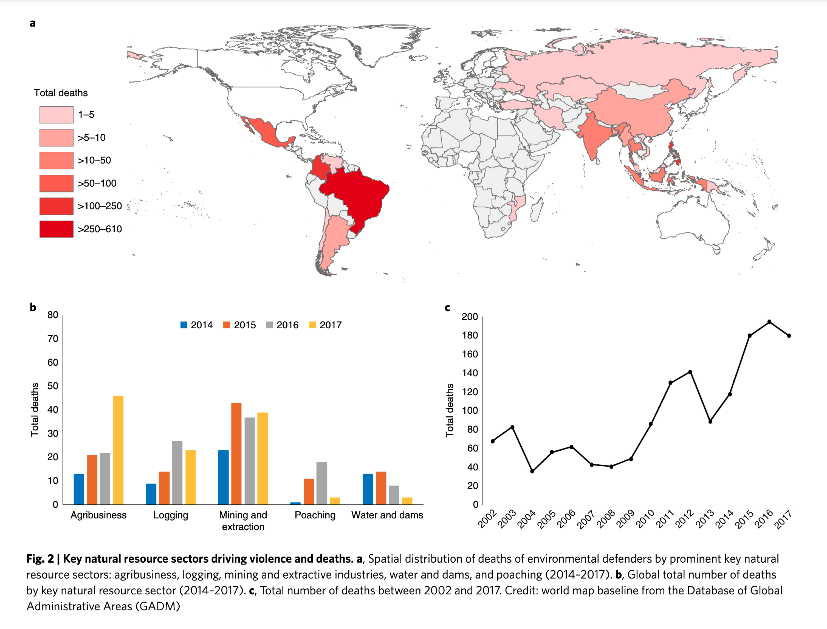Defending the environment is an increasingly deadly effort. According to new research, the number of people around the world who have died trying to protect land, water, forests, and other natural resources has doubled in the past 15 years.
Between 2002 and 2017, 1,558 people across 50 different countries were killed for protecting the environment, a new study published in the journal Nature Sustainability found. This is more than the number of British and Australian soldiers who have been killed in active duty overseas in war zones during the same period. And it is almost half the number of U.S. soldiers who have died fighting in Iraq and Afghanistan since 2001.
Environmental defenders include people such as community activists, lawyers, journalists, staff from non-governmental organizations, members of social movements, and indigenous peoples. The study sought to look specifically at deaths related to individual people or communities due to acts of resistance and/or efforts to protect land or environmental rights as opposed to large-scale armed conflict rooted in clashes over natural resources.
“People are dying to protect their livelihoods, along with the forests, lands and ecosystems that are essential for all our futures,” the study reads.
In 2017 alone at least 185 people were killed related to their efforts to defend the environment. And in 2018, a year not included in the study, 164 people were killed according to Global Witness, which monitors these deaths and whose data was used in the study.
But as the researchers note, these deaths “represent the ‘tip of the iceberg’ of the violence that environmental defenders face.”
“For every defender murdered, thousands more face direct violence, threats and psychological intimidation, and more invisible cultural and structural violence,” the study states.
The varying extent of free media and human rights monitors in some countries also limits the amount of data available — some deaths may not ever be recorded officially.

More than anyone else, indigenous people represented 40% of all deaths in 2015 and 2016, and 30% in 2017. Most of these deaths occurred in the Philippines and Colombia.
Central America is the most dangerous region, with 36% of all deaths between 2015 and 2017, followed by South America (32%) and Asia (31%).
The most number of deaths tied to the agriculture sector between 2014 and 2017 took place in Brazil and the Philippines. Brazil is also responsible for the most deaths linked to logging. Mining and extraction sector deaths were highest in the Philippines, Colombia, and India while poaching-related deaths were most frequent in Vietnam and the Democratic Republic of Congo.
A large factor contributing to this violence, the study states, is “weak rule of law.” For instance it is estimated that on average just over 10% of these murders are convicted globally — this is compared to an average 43% of homicides being convicted worldwide according to 2012 figures cited in the study.
Additionally, violence is often perpetuated by corruption within local policy and judiciary branches, leading to many deaths being improperly investigated. Sometimes, it’s the police or government that are directly responsible for the deaths or have financial ties to those responsible.
Many of these deaths also happen in remote areas with little government or police presence, which means it’s a lot harder to gather evidence.
One way or another, this creates a situation in which “the killers essentially know they’re not going to get caught,” Mary Menton, a research fellow in environmental justice at the University of Sussex in England and a co-author of the new study, told Scientific American.
The study highlights two political leaders who have particularly egregious records. Under President Rodrigo Duterte in the Philippines, there was a 71% increase in the murder of environmental defenders between 2016 and 2017.
Following the election of Brazil’s President Jair Bolsonaro, fears have mounted that indigenous peoples defending their environment will be increasingly targeted. As the study notes, Brazil is consistently the country with the highest number of deaths of environmental defenders — especially indigenous peoples — and Bolsonaro has vowed to relax both gun laws and environmental protections, as well as label NGOs and activists as terrorists.
While no deaths have occurred during the period studied in places such as the United States and the U.K., the study warns that the atmosphere in these two countries is becoming more hostile.
In 2018, three fracking protesters in Britain were convicted of causing public nuisance for their non-violent direct action — the first time environmental activists have received jail time for a protest in the U.K. since 1932.
Meanwhile, in the United States, the Dakota Access Pipeline protests saw several demonstrators hospitalized after authorities used a water cannon in sub-zero temperatures to disperse crowds. And increasingly under President Donald Trump, new laws are being proposed at both the state and federal level to crackdown on pipeline protesters — from increased fines and jail time to increasing the severity of certain actions, such as trespass or planning a protest, from a misdemeanor to felony.



